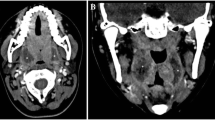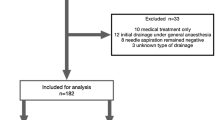Abstract
Objective
To find out the usability and advantage with regard to the advent of new and more costly antibiotics. In the treatment of Peritonsillar abscess the demonstration of, both aerobic and anaerobic organisms has raised the question of possible need to treat with antibiotics effective against anaerobes.
It was in this very context that this study was planned to find out if we still have an economically and easily available antibiotic to treat Peritonsillar abscess.
Conclusions
Injectable penicillin is the drug of choice in PTA as GABHS and staphylococcus aureus coagulase positive are the most common organism associated with this condition. Even where penicillin resistant organism is present, effective management of the abscess is possible if it is drained well and weak hydrogen peroxide gargles are used along with injectable penicillin.
Similar content being viewed by others
References
Hardingham M (1987) Peritonsillar infection. Otolaryngology Clinics of North America 20(2):273–278
Collee JG, Duguid JP, Fraser AG (1996) Laboratory strategy in the diagnosis of infective syndrome In: Mackie and McCartney Practical Microbiology Ed 14th eds Collee JG, Marmion BP, Fraser AG, Simmons A. New York; Churchill Livingstone 56–62
Brook I, Frazier E, Thompson DH (1991) Aerobic anaerobic microbiology of peritonsillar abscess. Laryngoscope 101: 289–292
Brook I (1992) Diagnosis and management of anaerobic infections of the head and neck. Annals of Otology, Rhinology and Laryngology 101:9–15
Savolainen S, Somer JHR, Makitie AA, Yiikoshi JS (1993) Peritonsillar abscess: Clinical and microbiologic aspect and treatment regimens. Achieves of Otolaryngology Head Neck Surgery 119:521–524
Kieff DA, Bhattacharya N, Siegel NS, Salman SD (1999) Selection of antibiotics after incision and drainage of peritonsillar abscess. Otolaryngology Head and Neck surgery 120: 57–61
Hallander HO, Floodstorm A, Holmberg K (1975) Influence of the collection and transport of specimens on the recovery of bacteria from peritonsillar abscess. Journal of Clinical Microbiology 2:504–509
Jokiph AMM, Jokippi L, Sipila P, Jokinen K (1988) Semiquantative culture results and pathologic significance of obligate anaerobes in peritonsillar abscess. Journal of Clinical Microbiology 26:957–961
Maharaj D, Rajah V, Hemsley S (1991) Management of peritonsillar abscess. Journal of Laryngology and Otology 105: 743–745
Author information
Authors and Affiliations
Corresponding author
Rights and permissions
About this article
Cite this article
Varghese, A.J., Chaturvedi, V.N. Peritonsillar abscess — Do we need anaerobic cover?. Indian J Otolaryngol Head Neck S 59, 233–236 (2007). https://doi.org/10.1007/s12070-007-0068-4
Published:
Issue Date:
DOI: https://doi.org/10.1007/s12070-007-0068-4




